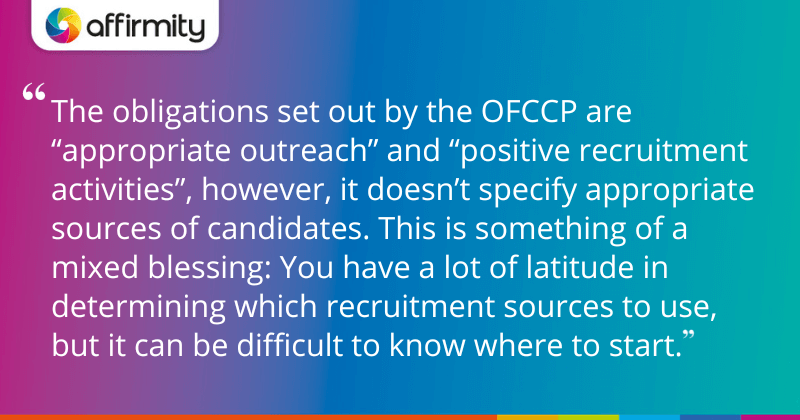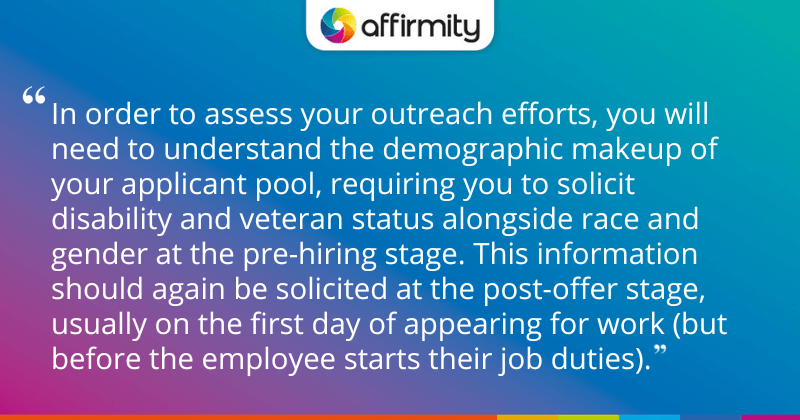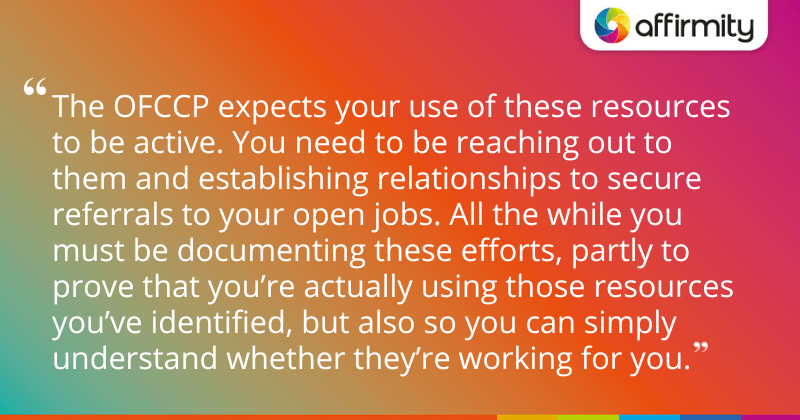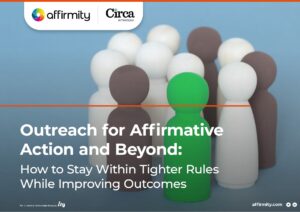Your outreach efforts are one of the most important tools in your affirmative action program (AAP) toolkit. Without drawing up and executing plans that improve the diversity of your pipeline you’ll struggle to create lasting change in your organization, risking OFCCP interventions. In this article, we’ll examine your outreach obligations, discuss how to prove that you’re executing your plans, and reveal 5 key resources you should be using.
Armed with the knowledge of where you’re falling short—revealed by your statistical analysis and subject to extensive work cleansing and correcting your data and collection methodology—federal contractors are required to have action-orientated outreach plans covering:
- Females
- Minorities
- Individuals with disabilities
- Protected veterans
Evidence must also be provided that you are acting on these plans, and thereafter assessing their effectiveness on an annual basis. Whether you achieve this through a simple spreadsheet, or a full applicant tracking system (or some other method) doesn’t necessarily matter, provided the method doesn’t obstruct the goal of accurately and efficiently recording your progress.

Contractors are also obliged to share these obligations with their subcontractors by inserting specific language into their contracts so that they’re aware of what is required and that they too should be conducting outreach.
The obligations set out by the OFCCP are “appropriate outreach” and “positive recruitment activities”, however, it doesn’t specify appropriate sources of candidates. This is something of a mixed blessing: you have a lot of latitude in determining which recruitment sources to use, but it can be difficult to know where to start, and the road to finding the right sources can be a long one.
FURTHER THOUGHTS ON YOUR DATA | ‘4 Signs That Your Applicant Data Won’t Pass an OFCCP Audit’

What You’re Obliged to Record
Your AAP’s outreach self-assessment should include a review of the data you’ve collected from your efforts across a three-year period. The three-year period allows the OFCCP to assess whether you’re making directional changes based on the results of your efforts—three full years of using the same, underperforming sources is unlikely to be looked on favorably.
Your documentation must also describe how you arrived at the criteria you use for assessing your outreach. Other than dictating that you must include 44(k) data (counts of veterans and individuals with disabilities) these criteria are largely not something the OFCCP prescribes.
In order to assess your outreach efforts, you will need to understand the demographic makeup of your applicant pool, requiring you to solicit disability and veteran status alongside race and gender at the pre-hiring stage. This information should again be solicited at the post-offer stage, usually on the first day of appearing for work (but before the employee starts their job duties).
Because disability status can change, it must be formally re-surveyed every five years. At least one reminder must additionally be sent during this period, detailing how employees can update their disability status if they need to. However, in all interactions it must be remembered that disclosure of this information is voluntary: you cannot pressure any individual to self-identify.
ADVICE FOR AUDITS | ‘How to Prepare Your Employees for On-Site Visits From OFCCP Auditors’

What Outreach Resources Options Are There?
There are many resources available to your organization, both locally and nationally, that will help you improve the diversity of your pipeline and connect you with veterans, individuals with disabilities, minorities, and women. These options include:
1) Local Veterans Employment Representatives
There will almost always be a veteran’s group that serves each of your local communities. Even if one isn’t located in a specific city, there will be one that includes the city as part of its territory. At any given point in time these groups typically have a caseload of anywhere between 40 to 50 veterans, making them an obvious resource to reach out to.
2) The Division of Vocational Rehabilitation
Primarily serving individuals with disabilities, these state-level services can help you reach out to a pool of potential candidates. They also provide you with access to certain employer incentive programs when you hire somebody with a disability.
3) One-Stop Career Centers and State Job Boards
Your local government employment agencies are potentially a valuable source of migrant workers, people transitioning between jobs, older workers, minorities, women, individuals with disabilities, and veteran labor.
4) Non-Profits
In your community, there will be a significant ecosystem of non-profit organizations providing employment placement services to the demographic groups you wish to attract.
5) Job Platforms and Employment Websites
A number of services, including Circa via Diversity Jobs, can give your organization access to databases and directories of organizations that will be interested in your open positions. These organizations opt in to get notified first about new jobs before re-circulating them among their members and people they’re working with.
The OFCCP expects your use of these resources to be active. You need to be reaching out to them and establishing relationships to secure referrals to your open jobs. All the while you must be documenting these efforts, partly to prove that you’re actually using those resources you’ve identified, but also so you can simply start to understand whether they’re actually working for you.
Bear in mind that the nature of your outreach is also important, and not just the organizations you work with. Job fairs, for example, may be good for attracting certain demographics but may be less effective for others. Explore different ways of working with your resources before writing them off entirely.
MORE ON AFFIRMATIVE ACTION | ‘Getting the Business On Your Side: How to Talk About Affirmative Action Data With Everyone Else’
Continue Reading: Keep Learning About Outreach for Affirmative Action (and Beyond)
This article is an extract from our recent guide, “Outreach for Affirmative Action and Beyond: How to Stay Within Tighter Rules While Improving Outcomes”. Download the full ebook to enjoy the following additional insights:
- An explanation of the role of outreach alongside the other key components of your affirmative action program
- Advice on collecting accurate AAP data (and cleansing what you collect)
- Examples of reports for community and diversity outreach, candidate referrals, VEVRAA job listings, and more

Download the full ebook today.
Ready to start building a better affirmative action program? Contact Affirmity today to explore your options.
 About the Author
About the Author
Roy Zambonino is a senior solutions consultant at Affirmity. He is responsible for demonstrating and discussing Affirmity’s wide range of DE&I and affirmative action planning products and services with existing and prospective clients.
As a former project manager, Mr. Zambonino is able to draw upon the best practices he’s observed over the last 20+ years helping prepare and implement programs. This work has involved companies ranging in size from a few hundred to several hundreds of thousands of employees, and spans across many industries including retail, construction, healthcare, banking, and finance. Mr. Zambonino has a Bachelor’s and Master’s degree in Business Administration.
